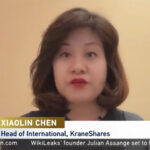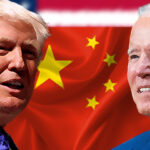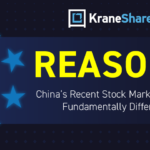Is Hong Kong Part of China?
Yes, and...

Hong Kong is part of China but it also has a unique history, culture and political system. Regardless of the differences, Hong Kong and Mainland China are inextricably linked and are increasingly working together to lead China’s booming economy into the future. The Hong Kong-Mainland relation is paramount to China’s ascent on the world stage and opening up of its economy.
Before Britain: Imperial Hong Kong
Hong Kong was originally controlled by the Baiyue, a Chinese tribe that migrated to Vietnam after Emperor Qin took control of the territory in the Third Century BCE.1 This conquest was a part of his campaign to unify China, which was a collection of warring states at the time. Although the Qin Dynasty eventually ended, Hong Kong would have several roles as time progressed, including a major center of salt production2, a naval base to protect China’s coast3, and a temporary court of the Song dynasty.4 However, Hong Kong did not truly flourish as a center of trade until the beginning of British rule and has since continued to hold a prominent role in the Asian markets alongside Mainland China.
Hong Kong Under British Rule
There were three crucial events that brought Hong Kong under control of the British Empire. First, Britain gained control of Hong Kong Island in 1841 after its victory in the First Opium War.5 Second, the British integrated Kowloon, an area north of Hong Kong Island, in 1860 after the Second Opium War.6 Third, China leased the New Territories to the British for 99 years in 1898.7 That year marked the beginning of British rule and shaped Hong Kong as we know it today.
The British designated the island as a free port, which encouraged international trade. Many Mainland Chinese from Canton, which is now Guangzhou, emigrated from the Mainland to the island for commercial incentives. As a result, Cantonese became the most used Chinese dialect in Hong Kong and is still taught in schools and spoken colloquially. Eventually, English also became a common language as the number of British expats on the island grew. To this day, Hong Kong’s dialect has a unique mixture of Cantonese and English vocabulary and idioms.
The Handover
As its lease on the New Territories was about to expire, Britain decided to return all of Hong Kong to China. The two nations signed the Joint Declaration in 1984, agreeing to transfer control of Hong Kong in 1997. The deal, which is known as the Handover, signaled the end of 99 years of British rule. On June 30, 1997, Hong Kong became reunited with China, but Hong Kong retained unique rights and privileges as a special administrative region (SAR).8
One Country, Two Systems
Since the Handover, Hong Kong and Mainland China have strengthened ties, gaining important benefits from being reunited. The use of Mandarin, the most common Chinese dialect, has become more prevalent in Hong Kong. Mainland China’s increasing cultural influence on Hong Kong is indicative of China’s status as a powerhouse in Asia and the world.
Both Hong Kong and the Mainland control huge economic power. China has already surpassed the United States in terms of purchasing power parity and is only slightly lagging behind in terms of real GDP.9 Additionally, Hong Kong has been a center of trade and commerce since the beginning of British rule. While the Mainland can benefit from the island’s established commercial system, Hong Kong also serves as an international entry point for the Mainland’s increasingly expanding markets.
Key Connection Between Hong Kong and Mainland Exchanges
One important aspect of Hong Kong’s autonomy is its ability to govern its economy. Hong Kong’s influential stock exchange and currency are the foundations for its role as an economic powerhouse.
The Hong Kong Stock Exchange (HKEx) is the sixth largest in terms of market capitalization.10 The exchange is unique in that it lists 1800 companies overall, of which 800 are Hong Kong based, 900 are Mainland Chinese, and 100 are international.11 An interesting nuance of HKEx is that global index providers such as MSCI and FTSE classify Mainland Chinese companies listed on this exchange as emerging market stocks while Hong Kong companies are designated as developed market stocks.
There can be a price disparity between a dually listed Chinese company’s stock listed on HKEx versus the same company’s stock listed on the Mainland exchanges. Currently, there are 80 companies with a dual listing on HKEx and the onshore exchanges. Being listed on HKEx has traditionally allowed Mainland Chinese companies to gain exposure to foreign investment.
Unlike HKEx, foreigners were limited in their trading capabilities in the onshore exchanges of Shanghai and Shenzhen, which are the fourth and seventh largest stock exchanges globally.12 However, the Shanghai-Hong Kong Stock Connect, which started in November 2014, leveraged the international prowess of the HKEx to provide greater international access to the Mainland markets.
This system allows foreigners to trade between the two exchanges with little to no restrictions. A Shenzhen-Hong Kong equivalent is rumored to be in the works as well. The Shanghai-Hong Kong Connect has already opened the door for lucrative investments as well as an increased exchange in ideas between the Mainland and Hong Kong.
HKD vs. RMB
Hong Kong uses its own currency, the Hong Kong Dollar (HKD), which is pegged to the United States Dollar (USD) at a fixed rate.13 Only Hong Kong can print and issue the HKD. Currently, HKD is the thirteenth most traded currency in the world, right behind the Russian ruble.14
Mainland China’s official currency is called the Renminbi (RMB). As a whole, the RMB is the ninth most traded currency.15 Chinese RMB is separated into offshore RMB (CNH) and onshore RMB (CNY). Today, most of the world’s CNH is traded in Hong Kong. The two markets were established in line with China’s policy of internationalizing its currency. As Mainland China further deregulates and encourages foreign participation in its economy, CNY and CNH will eventually become one international RMB. For now, however, China is keeping the CNY market tightly guarded in order to prevent potential volatility from foreign currency speculators investing in the currency.
The primary difference between the two currencies is that China’s central bank, the People’s Bank of China, sets a band in which CNY can float in order to monitor its exchange rate with the USD. In contrast, CNH is traded internationally so its exchange rate can go outside the band set for CNY. As a result, there can be a disparity between CNY-USD and CNH-USD exchange rates.
China has also allowed foreign companies to issue bonds, nicknamed “dim sum” bonds, in CNH. McDonalds issued the first dim sum bond. While these bonds are appealing due to the increasing popularity of the RMB, Mainland China’s interbank bond market, which makes up 95% of its aggregate bond market volume, has started to open up. Investors can now access the world’s third largest bond market.16
Despite the contrast between Hong Kong and Mainland China, the two regions are working together to deliver China’s markets to the world. Hong Kong will become fully integrated into China in 2047, allowing plenty of time for the best parts of both systems to meet and work together. We believe that the combination of Mainland China’s flourishing domestic market and Hong Kong’s established commercial system will continue to generate attractive investment opportunities for global investors for many years to come.
- Meacham, William. Defining the Hundred Yue
- http://industrialhistoryhk.org/salt-production-oldest-industry-hong-kong-tai/
- Gao, T.Q. History of Hong Kong: Ancient and Modern
- Barber, Nicola. Hong Kong (Great Cities of the World)
- Encyclopedia Britannica. Treaty of Nanjing
- www.chinaforeignrelations.net/treaty_beijing. Convention of Peking
- www.chinaforeignrelations.net/node/151. Convention for the Extension of Hong Kong
- www.mtholyoke.edu/~cngai/jointdeclaration.htm. Sino-British Joint Declaration
- Data from International Monetary Fund as of 10/2014
- Data from World Exchanges as of 1/31/2015. Based on equity exchanges with reported data
- Data from Hong Kong Stock Exchange as of 4/20/2015
- Data from World Exchanges as of 1/31/2015. Based on equity exchanges with reported data
- Data from Hong Kong Monetary Authority as of 8/17/2011
- Data from Business Tech as of 9/13/2013
- Data from Business Tech as of 9/13/2013
- Data from Goldman Sachs as of 6/2014

















